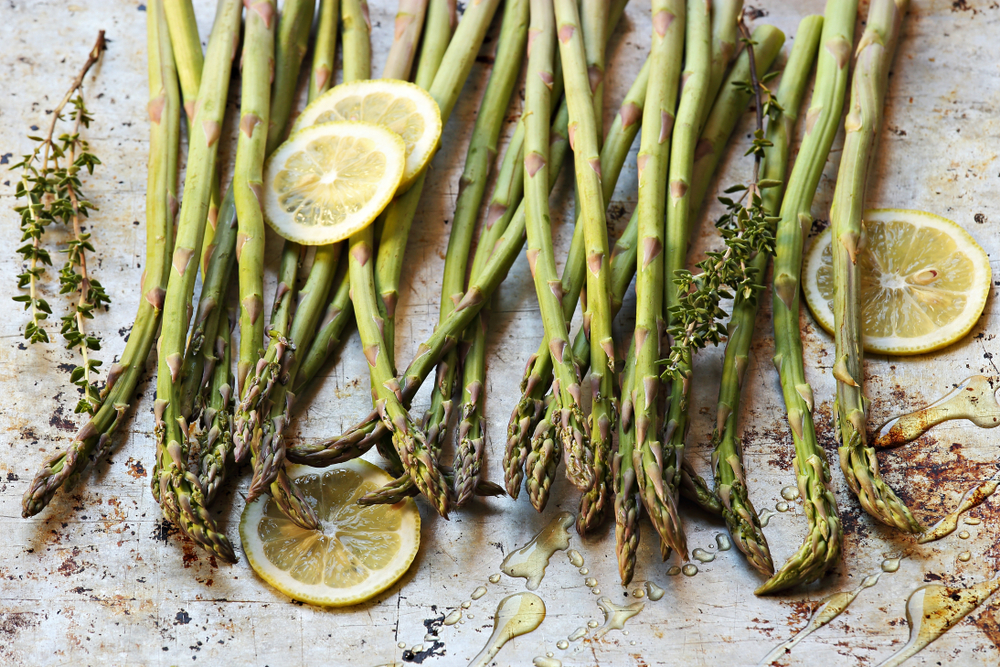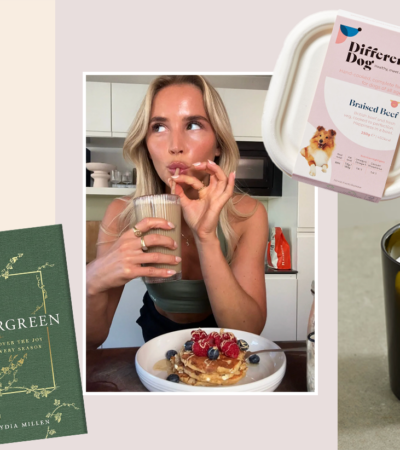Is there anything better than when the days start to get longer, the first blooms appear on the trees and you start feeling like spring is around the corner? Still in the grip of lockdown, the prospect of brighter skies and warmer weather has never been something we’ve looked forward to more. And Spring doesn’t only bring with it warmer weather, blossoming flowers and singing birds, but also lots of delicious foods that are at their peak this time of the year. So look out for what’s in season, go to your local farmer’s market on the weekend and pick up local and seasonal veggies to fill up your plate with. They will bring so much colour and taste to your meals along with a concentrated dose of nutrition! Here are eight of our favourite seasonal foods for Spring and their health benefits!
Asparagus
It’s packed with fibre, vitamins A, C, E, K, B6, as well as folate, iron, copper, calcium and chromium, a trace mineral that enhances the ability of insulin to transport glucose from the bloodstream into cells.
Asparagus also contains high levels of the amino acid asparagine, making it a natural diuretic helping the body getting rid of excess salt and fluid, as well as several antioxidants like vitamin E and anthocyanins, which could help your body fight damaging free radicals. Plus, it’s a source of prebiotics which feeds the beneficial gut bacteria helping them grow and thrive.
When preparing asparagus, try not to either overcook or undercook it to preserve all its nutrients. Lovely steamed, lightly roasted, grilled or tossed into a pasta meal with olive oil, cherry tomatoes, lemon and basil or a creamy risotto. Yum!
Cauliflower
It contains a good amount of vitamin C along with vitamin K, B vitamins and minerals like potassium, magnesium, phosphorus, manganese and fibre. It’s also a source of antioxidant compounds beta-carotene, kaempferol, quercetin and rutin. But cauliflower is especially well known for containing anti-inflammatory nutrients like indole-3-carbinol or I3C, a compound that may help prevent inflammatory responses and nutrients that support and promote liver detoxification pathways called glucosinolates (sulfur-containing compounds that can activate detoxification enzymes).
Cauliflower is so nice roasted with a curry, steamed, in soups or mash but also try it steamed and then frozen in smoothies. It adds such a nice texture and adds an extra nutrients punch without being noticed.
Purple Sprouting Broccoli
Purple sprouting broccoli is a great source of vitamin A, C, carotenoids, calcium, folic acid, iron, fibre and also contain sulforaphane, a powerful detoxification compound. It can support liver detoxification pathways function and can help trigger an important antioxidant response by the cells. Plus, it can directly block the ability of certain carcinogens to interact with DNA protecting it from damage.
Have them as a side steamed with lemon or olive oil or roasted in the oven and why not have them with pasta sautéed with a nice creamy pesto?
Savoy Cabbage
Rich in vitamins A, K, C and B6 as well as iron, manganese, folate, potassium, calcium and magnesium and high in sulphur containing compounds. Sulphur along with vitamin C is needed for the production of keratin, a protein substance necessary for healthy hair, nails, and skin.
Plus, just like cauliflower, cabbage is rich in glucosinolates which can neutralise certain carcinogenic substances and support liver function.
Perfect to add to soups and stews but also sautéed with other fragrant and crunchy veggies to pair with rice or noodle dishes in a nice stir-fry.
Cucumber
This crunchy veggie is rich in fibre, water, folate, vitamins C and K, B vitamins, copper, potassium, which is associated with lower blood pressure levels, manganese and numerous antioxidants. Vitamin C and beta-carotene are main ones but also quercetin and kaempferol.
Cucumber and cucumber juice can provide relief from heartburn, stomach acidity, gastritis and peptic ulcer and cucumber extract can help reduce inflammation by inhibiting the activity of pro-inflammatory enzymes.
The best way to enjoy these cooling and hydrating veggies other than as an eye mask, is to grate or chop them and add them to salads, turn them into noodles and if you love juices, definitely put some in there along with greens, celery, fennel, ginger and lemon.
Watercress
It contains important nutrients such as vitamins A and C, folate, minerals like calcium, iodine and phosphorus, antioxidants and omega 3s, especially alpha-linolenic acid.
Brassica vegetables like watercress have strong anti-inflammatory effects as they’re all rich in sulforaphane, an antioxidant that fights inflammation by reducing the levels of cytokines, pro-inflammatory markers. They are also a good source of iron, calcium, magnesium and potassium which along with the vitamins mentioned above are necessary to support skin, hair, nails, bones and teeth health.
Watercress is perfect in salads and sandwiches to add a slight spiciness but also lightly steamed at the last minute in side dishes. And why not pimp up your homemade pesto with a handful of watercress.
Radishes
These crunchy veggies are packed with vitamins A, C, E, B6, and K along with zinc, potassium, phosphorous, magnesium, copper, calcium, iron and manganese.
Plus, they contain fibre and antioxidants such as anthocyanins, the same that are found in purple and red coloured fruits and vegetables. These compounds possess good anti-inflammatory properties that can help reduce the risk of inflammatory diseases like cardiovascular and protect our cells from oxidative damage.
They are great thinly sliced in a salad or mixed into side dishes paired with spices like dill, garlic or mustard as they add a crunchy texture and a slight spiciness just like watercress. And if you don’t like the peppery taste, try them pickled and fermented which also adds beneficial probiotics.
Celeriac
You may not be too familiar with this root vegetable which has nutty, earthy, and sweet flavour and tastes a bit like celery and parsley. It is mainly added to soups, stews curry or even consumed raw, shaved into salads or used to make raw rice and ravioli filled with a nice cheesy filling.
Despite not being bright or green coloured, it’s extremely rich in beneficial nutrients. It contains numerous antioxidants, good amounts of fibre, vitamin C, B complex vitamins, high amounts of vitamin K and potassium, necessary for bone metabolism along with other essential minerals like copper, phosphorus, manganese, calcium and iron.
So next time you’re out grocery shopping, try some of the foods that are in season and that you may not that often. Remember the health of your body and mind it’s not just about the most popular superfoods but about having a daily dose of plant medicine. Enjoy the longer and brighter days and bring the same energy to your plate!
words by Alessandra Felic
READ MORE: Quick Toasted Quinoa Bowls














